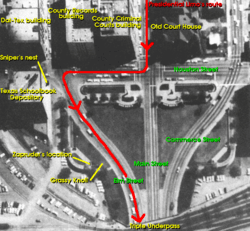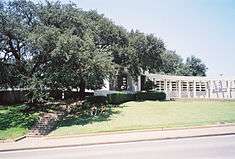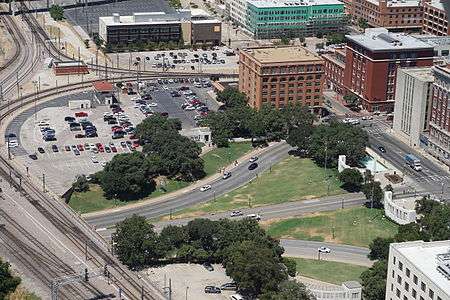Dealey Plaza
|
Dealey Plaza Historic District | |
 View from southwest, with the former Texas School Book Depository building at left, and the Dal-Tex Building, right next to it | |
| Location | 411 Elm Street, Dallas, Texas |
|---|---|
| Coordinates | 32°46′43″N 96°48′30″W / 32.77861°N 96.80833°WCoordinates: 32°46′43″N 96°48′30″W / 32.77861°N 96.80833°W |
| Area | 15 acres (6.1 ha) |
| Built | 1940 |
| Architectural style | Chicago, Early Commercial, Romanesque |
| NRHP Reference # | 93001607[1] |
| Significant dates | |
| Added to NRHP | April 19, 1993[1] |
| Designated NHLD | October 12, 1993[2][3] |
Dealey Plaza /ˈdiːliː/, in the historic West End district of downtown Dallas, Texas (U.S.), is the location of the assassination of John F. Kennedy on November 22, 1963. The Dealey Plaza Historic District was named a National Historic Landmark in 1993 to preserve Dealey Plaza, street rights-of-way, and buildings and structures by the plaza visible from the assassination site, that have been identified as witness locations or as possible assassin locations.[2][3]
History
.jpg)
Dealey Plaza is a Dallas city park, built on land donated by early Dallas philanthropist and businesswoman Sarah Horton Cockrell. It was completed in 1940 as a WPA project[4] on the west edge of downtown Dallas where three streets converge (Main Street, Elm Street, and Commerce Street) to pass under a railroad bridge known locally as the "triple underpass."
The plaza is named for George Bannerman Dealey (1859–1946), a civic leader and early publisher of The Dallas Morning News, who had campaigned for the area's revitalization. Monuments outlining the plaza honor previous prominent Dallas residents and predate President John F. Kennedy's visit by many years. The actual monument honoring President Kennedy, in the form of a cenotaph, is one block away.
John F. Kennedy assassination


Dealey Plaza is bounded on the south, east, and north sides by 100+ foot (30+ m) tall buildings. One of those buildings is the former Texas School Book Depository building, from which, both the Warren Commission and the House Select Committee on Assassinations concluded, Lee Harvey Oswald fired a rifle that killed President Kennedy. There is also a grassy knoll on the northwest side of the plaza. At the plaza's west perimeter is a triple underpass beneath a railroad bridge, under which the motorcade raced after the shots were fired.

Today, the plaza is typically visited daily by tourists. The Sixth Floor Museum now occupies the top two floors of the seven-story former Book Depository. Since 1989, more than six million people have visited the museum.
The National Park Service designated Dealey Plaza a National Historic Landmark District in 1993, roughly encompassing the area between Pacific Avenue, Market and Jackson Streets and the former railroad tracks. Therefore, nothing of significance has been torn down or rebuilt in the immediate area. (A small plaque commemorating the assassination is located in the plaza.)
Visitors to Dealey Plaza today will see street lights and street signs that were in use in 1963, though some have been moved to different locations and others removed entirely. Buildings immediately surrounding the plaza have not been changed since 1963, presenting a stark contrast to the ultra-modern Dallas skyline that rises behind it.
Over more than half-a-century, Elm Street has been resurfaced several times; street lane stripes have been relocated; sidewalk lamp posts have been moved and added; trees, bushes and hedges have grown; and some traffic sign locations have been changed, relocated or removed. In late 2003, the city of Dallas approved construction project plans to restore Dealey Plaza to its exact appearance on November 22, 1963. As of 2004, voters had approved US$500,000 of the $3,000,000 needed.[5] The first phase of the restoration, which spent $700,000 for repair work and plumbing along Houston Streets, was completed in 2008.[6]
Grassy knoll

The grassy knoll is a small, sloping hill inside the plaza that became well-known following the assassination of John F. Kennedy. The knoll was above Kennedy and to his right (west and north) during the assassination on November 22, 1963.
This north grassy knoll is bounded by the former Texas School Book Depository building along the Elm Street abutment side street to the northeast, Elm Street and a sidewalk to the south, a parking lot to the north and east and a railroad bridge atop the triple underpass convergence of Commerce, Main and Elm streets to the west.

Located near the north grassy knoll on November 22, 1963, were several witnesses, three large traffic signposts, four sidewalk lamp posts, the John Neely Bryan north pergola concrete structure including its two enclosed shelters, a tool shed, one 3.3 foot (1 m) high concrete wall connected to each of the pergola shelters, ten tall, wide, low-hanging live oak trees, a five-foot (1.5 m) tall, wooden, cornered, stockade fenceline approximately 169 feet (53.6 m) long, six street curb sewer openings, their sewer manholes and their interconnecting large pipes and numerous 2 to 6 foot (0.6 to 1.8 m) tall bushes, trees and hedges.
The words "grassy knoll" to describe this area were first used by reporter Albert Merriman Smith of UPI, in his second dispatch from the radio-telephone in the press car: "Some of the Secret Service agents thought the gunfire was from an automatic weapon fired to the right rear of the president's car, probably from a grassy knoll to which police rushed." These words were then repeated on national television by Walter Cronkite in his second CBS News bulletin.[7]
Of the 104 Dealey Plaza earwitness reports published by the Commission and elsewhere, 56 recorded testimony that they remembered hearing at least one shot fired from the direction of the Depository or from near its Houston and Elm Streets intersection that was to the rear of the President, 35 witnesses recorded testimony of at least one shot fired from the direction of the grassy knoll or the triple underpass located to the right and front of the President, eight witnesses gave statements of shots fired from elsewhere, and five earwitnesses testified that the shots were fired from two different directions.[8]
The city of Dallas has arrested Robert Groden, who set up an information table on the grassy knoll and sells books and pamphlets regarding the incident, 82 times. The city of Dallas has lost the court cases all 82 times.[9]
Because of persistent debate, answered and unanswered questions, and conspiracy theories surrounding the Kennedy assassination and the possible related role of the grassy knoll, the term "grassy knoll" has come to also be a modern slang expression indicating suspicion, conspiracy, or a cover-up.
Gallery
 Dealey Plaza (2015) as viewed from Reunion Tower. Shown are the Texas School Book Depository and the "grassy knoll" in the upper center, the seven-story Dal-Tex Building, and the Dallas County Records Building.
Dealey Plaza (2015) as viewed from Reunion Tower. Shown are the Texas School Book Depository and the "grassy knoll" in the upper center, the seven-story Dal-Tex Building, and the Dallas County Records Building. A similar view of Dealey Plaza from the mid-1990s also includes the Art Deco Terminal Annex Federal Building in the lower-right foreground, the former Dallas County Courthouse made of red sandstone, and the Dallas County Criminal Courts Building adjacent to the Dallas County Records Building.
A similar view of Dealey Plaza from the mid-1990s also includes the Art Deco Terminal Annex Federal Building in the lower-right foreground, the former Dallas County Courthouse made of red sandstone, and the Dallas County Criminal Courts Building adjacent to the Dallas County Records Building.
References
- 1 2 National Park Service (2010-07-09). "National Register Information System". National Register of Historic Places. National Park Service.
- 1 2 "Dealey Plaza Historic District". National Historic Landmark summary listing. National Park Service. Archived from the original on 2012-11-13. Retrieved 2008-06-23.
- 1 2 Dallas County Historical Foundation (August 1991). "National Register of Historic Places Inventory-Nomination: Dealey Plaza Historic District" (PDF). National Park Service. Retrieved June 7, 2012. and Accompanying photos and maps, various dates (3.14 MB)
- ↑ "12 WPA Projects that Still Exist". How Stuff Works. Publications International, Ltd. Retrieved 2009-03-11.
- ↑ Dallas Morning News — 27 January 2004. "Assassination still stirs memories, debate 40 years later" by the Associated Press (AP). Retrieved 25 October 2006.
- ↑ http://www.dallasnews.com/news/community-news/dallas/headlines/20130307-dallas-dealey-plaza-restoration-nears-completion.ece
- ↑ Pages documenting this are held by Gary Mack, Curator of The Sixth Floor Museum at Dealey Plaza. The Man Who Named the Grassy Knoll at the museum's website, page found 2012-12-07.
- ↑ Dealey Plaza Ear witnesses. Two members of the Willis family who testified for the Commission reported in interviews with Nigel Turner for The Men Who Killed Kennedy that their testimony included witness reports of shots from the grassy knoll, but that these reports were omitted from publication by the Commission, although it did include their reports of shots from the Depository building. They also reported that the fatal shot came from behind them.
- ↑ Schutze, Jim (2016-09-08). "Dallas Has Now Lost 82 Cases Against Robert Groden. Someone Call Guinness.". Dallas Observer. Retrieved 2016-12-25.
Further reading
- Dealey, Jerry T. (2002). D in the Heart of Texas. JEDI Management Group. ISBN 0-9723913-0-4. (includes history of Dealey Plaza).
| Wikimedia Commons has media related to Dealey Plaza. |
External links
- Dealey Plaza live cam
- MU.edu: Dallas to Dealey: The History of Dallas and Dealey Plaza.
- MU.edu: The Man Who Named the Grassy Knoll, by Gary Mack of Sixth Floor Museum at Dealey Plaza.
- Dealey Plaza: scaled map — by Donald Roberdeau.
- Assassinationscience.com, Composite panorama of Dealey Plaza, by John Costella, using Zapruder film frames, Dallas Police Department photos taken in 1963, and photos by Jack White.

